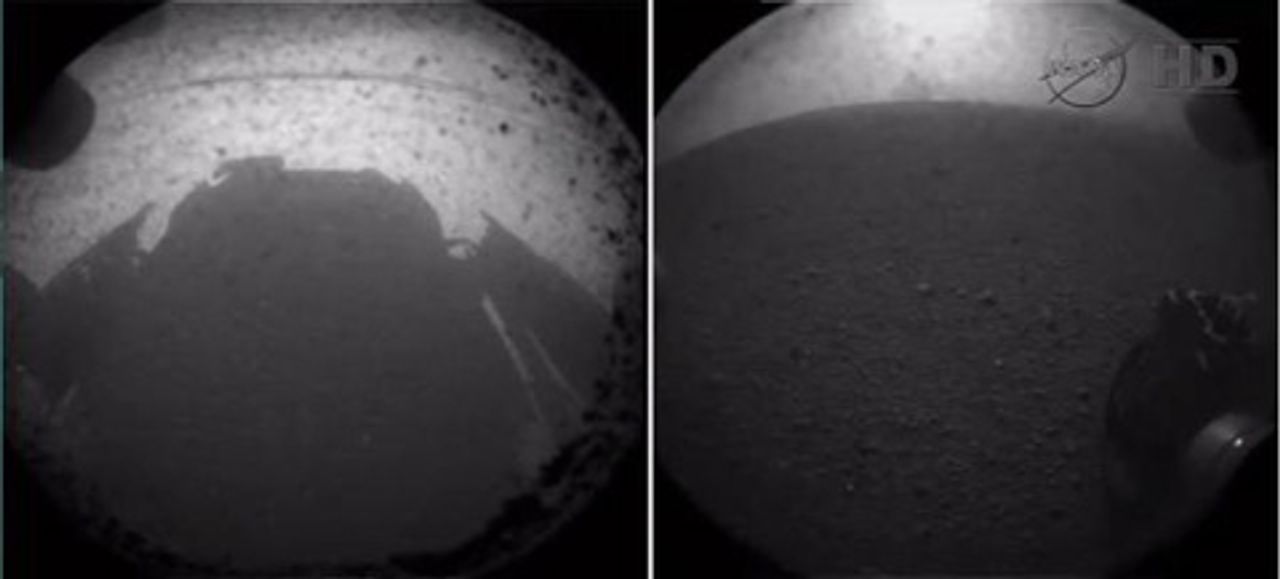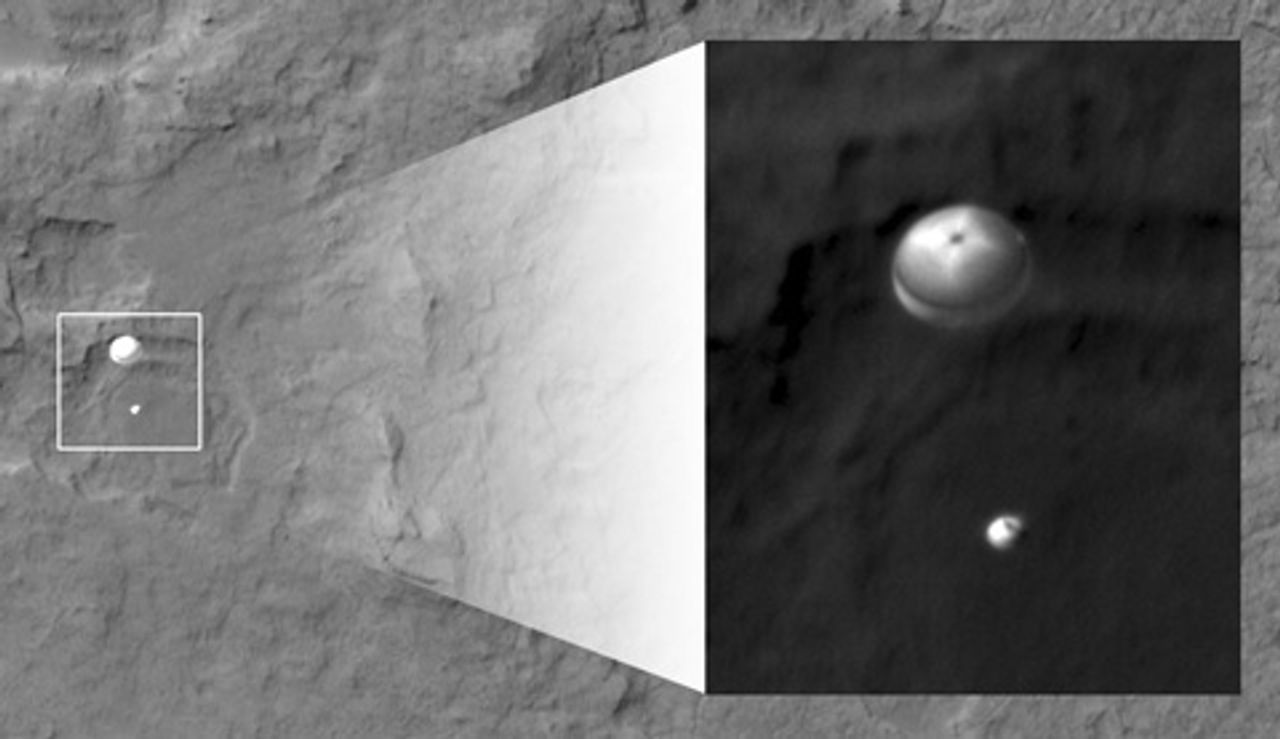In the most complex landing NASA has ever attempted, the Mars Science Laboratory successfully deposited the Curiosity rover on the surface of Mars on August 6, at 5:14 UTC. The landing came at the end of an eight-month journey of some 575 million kilometers. It is the beginning of the most sophisticated scientific analysis of Mars ever attempted.
On the basis of the latest reports from Curiosity, including the initial images sent back immediately after the landing, all systems appear to be operating normally.
 The first pictures from the Curiosity rover, telling the Earth that it has landed successfully and is operational. Credit: NASA TV
The first pictures from the Curiosity rover, telling the Earth that it has landed successfully and is operational. Credit: NASA TVThe purpose of the Mars rover will be to carry out extensive analysis of the geological history of Mars, with a particular emphasis on searching for evidence that the planet could have supported life. The rover is expected to remain in operation for at least one year.
The landing site was the Gale Crater, created by an impact on Mars that happened approximately 3.5 billion years ago. Within the crater is Aeolis Mons (Mount Sharp), which rises 5.5 kilometers above the base. The mountain is of particular interest because it could not have been caused by the impact that created the crater, so must be the product of natural processes on Mars, including a hypothesized earlier lake formation. As such, it houses a geological history of Mars that possibly spans one billion years.
Curiosity is armed with a plethora of scientific instruments for analyzing the geology of Mars. It will use a high resolution camera to determine which areas are of the most interest. Then it will use an infrared laser to get a spectra of the area it is targeting. If the spectra proves interesting, Curiosity can bring a microscope and x-ray spectrometer to bear. If further investigation is warranted, it can drill into the surface and retrieve a sample for detailed analysis.
The landing of Curiosity exceeds both the Phoenix lander (2008) and the previous rovers (2003) in complexity. Curiosity is five times the mass of the previous rovers, Spirit and Opportunity, and so could not be landed by airbags as they had been. In addition, the amount of moving parts involved meant that it could not be landed wholly by powered descent like Phoenix, because the resulting dust kicked up could hinder its movement.
The descent of Curiosity to the surface of Mars therefore required a highly complex group of operations and 500,000 lines of computer code.
The first six minutes of the landing, starting at first contact with the atmosphere, mirrored previous landing attempts. A combination of atmospheric braking and a parachute reduced the speed of the craft carrying the rover from 13,000 mph to 220 mph.
At this point, instead of deploying airbags and bouncing, eight thrusters were fired from a specially designed platform above the rover to lower it to approximately 25 feet above Mars. Curiosity was then lowered down to the surface using three cables, dubbed a skycrane. Once the rover touched ground (with a final speed of about 1 meter per second) the platform carrying it fired its thrusters sideways to crash land about 500 feet way.
The landing sequence was particularly remarkable because everything had to be automated. At the time of landing, Mars was approximately fourteen light minutes from Earth, which means that radio signals from Curiosity take fourteen minutes to reach the Earth. The landing process itself is only seven minutes, and so the spacecraft had to land without any human corrections. All indications are that this total sequence, with hundreds of extremely precise maneuvers, was executed without error.
Curiosity comes after a series of NASA successes at landing on Mars, from the Mars Pathfinder mission (Sojourner) in 1997, to Spirit and Opportunity and the Phoenix lander. Using the knowledge gained from these successes—as well as the failures, like the loss of the Mars Polar Lander in 1999—the engineering team for Curiosity was able to achieve an impressive feat.
Curiosity is the newest addition to the family of scientific instruments looking at Mars. The previous set of rovers, Spirit and Opportunity, landed in 2003 for what was slated as a 90-day mission. However, Spirit lasted until May 2011, and Opportunity still continues its operations.
Orbiting Mars are NASA’s Mars Reconnaissance Orbiter and Mars Odyssey, along with the European Space Agency’s Mars Express. All three orbiters played roles in assisting the landing of Curiosity. As the rover was descending on Mars, radio signals to Earth were blocked by Mars itself. To compensate, Mars Odyssey acted as the relay point for the descending craft, taking Curiosity’s signals and sending them to the Deep Space Network relay point in Canberra, Australia, which then sent the messages to the Jet Propulsion Laboratory in California.
The Mars Express recorded Doppler information on the landing craft, tracking it as it traveled down to Mars. Finally, the Mars Reconnaissance Orbiter used the extremely powerful HiRISE camera for mapping the landing site. It also captured a picture of Curiosity during the deployment of the parachute.
 A picture of the Curiosity rover taken by the Mars Reconnaissance Orbiter during Curiosity’s landing sequence. Credit: NASA/JPL-Caltech/Univ. of Arizona
A picture of the Curiosity rover taken by the Mars Reconnaissance Orbiter during Curiosity’s landing sequence. Credit: NASA/JPL-Caltech/Univ. of ArizonaIt will take some time before Curiosity is fully operational. Most of the instruments will be turned on over the next few days. This will allow color panorama pictures of Mars to be taken to better determine where precisely Curiosity is, and allow scientists to decide what will be done first. The initial estimates of the rover’s location place it to be only slightly off from the target within Gale Crater.
The successful landing of Curiosity is a welcome testament to the power of science, planning and international cooperation—under conditions of growing national antagonisms, relentless cuts to scientific funding, and the endless glorification of individual wealth. It is, at the same time, only an indication of what is possible once the principle of corporate profit is overcome, and the ruthless domination of the corporate and financial elite ended.
The author also recommends:
Mars rovers mark seven years on the planet’s surface
[22 January 2011]
Phoenix spacecraft lands near Mars polar icecap
[30 May 2008]
